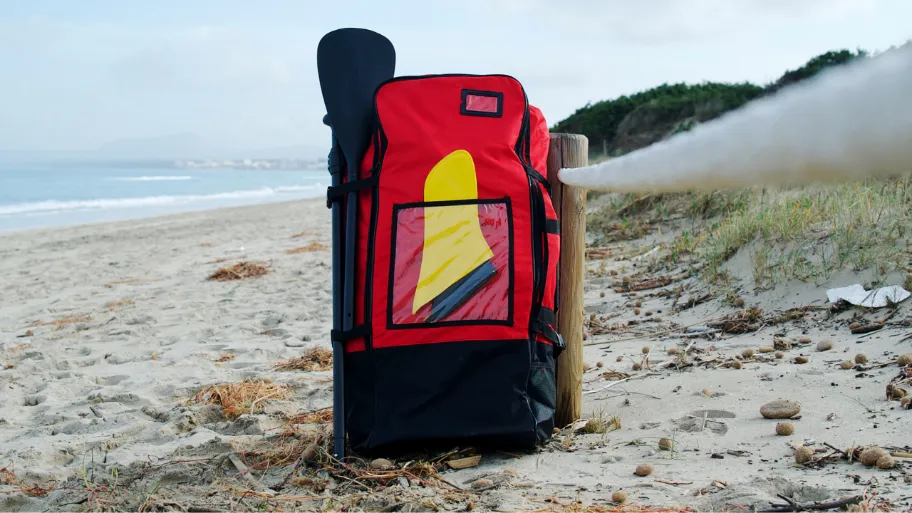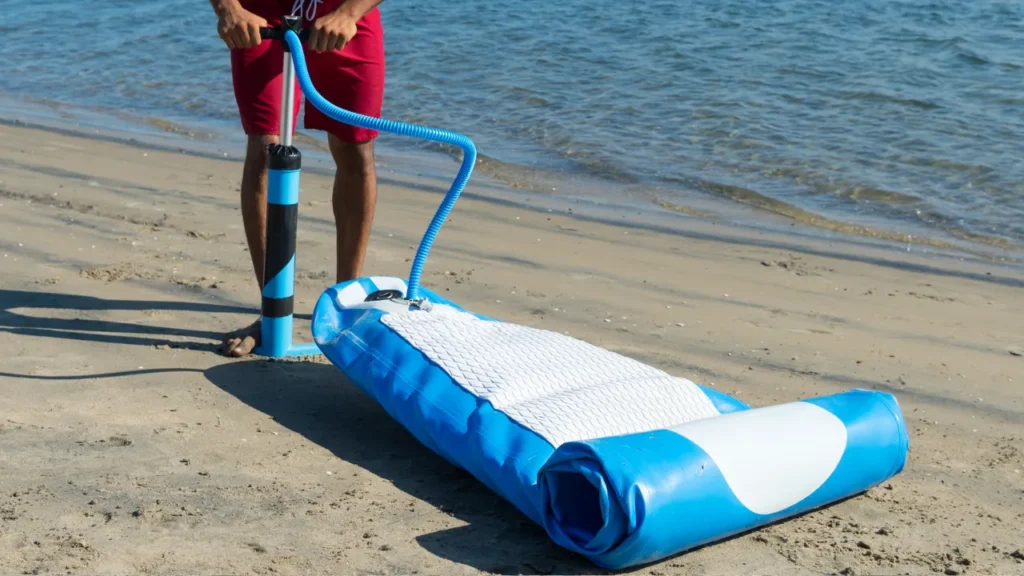After a day spent on the water it's then time to pack away your SUP and store it until your next outing. But if you have an inflatable board you might be wondering whether you have to pack it away in its bag or if you can just leave the board inflated.
Leaving it inflated is obviously easier, but will it damage the board at all?
You can store your stand up paddle board either inflated or deflated it doesn't matter. If keeping it inflated make sure to release some air and store it slightly below it's usual PSI rating, but not so much it gets floppy. Never store heavy items on top of your inflated SUP as it can damage the material.
It's important to slightly deflate your board before storage because if the garage or storage space gets hot the air inside your board can expand putting stresses on the seams and can lead to over expansion.
You also don't want to place anything heavy on top of the board as this can lead to dents in the material that won't come out and it can also increase the pressure causing over expansion issues.
It's best to store your inflated board lying down either on the ground or across a board rack.
If you're storing your board deflated just make sure you clean and fully dry it prior to storage otherwise mold can grow which can ruin the plastic.
Storing Your SUP Inflated
The advantage to storing your SUP inflated is that it saves a fair amount of time when you want to use your SUP since you don’t need to worry about completely inflating it – which we all know can be tiring on the arms when you're pumping away.
It also has the advantage of keeping your board dry so moisture doesn't get stuck in it and mold starts to grow like can happen when you roll or fold your paddle board.
It's perfectly fine to store your stand up paddle board inflated for extended periods of time and it shouldn't do any damage to the board itself, ensuring you store it correctly.
You should store your SUP in a cool environment with no direct sunlight as the harmful UV rays will break down and damage the plastic over time.
Ideally you want to keep storage temperatures between 40-110ºF/5-42ºC. Any higher than this can start to melt the plastic in some circumstance or cause deforming to happen and freezing temperatures can make the plastic brittle and more likely to break.
You also want to slightly deflate your board below the normal recommended PSI range. If not, this could lead to over expansion and a deforming of the board or too much stress on the seams of the board.
This is due to the air inside which expands in warmer temperatures. I would be concerned about this especially on a cheaper SUP, since it could damage the board by stretching the material.
Deflating your board to around 5 psi below normal recommended range should be fine and allow for that expansion. You don't want to board to be too floppy as this could cause creases if stored on a 2 arm board rack.
Before you take your inflated SUP out again, top up the PSI a little since it will naturally lose air pressure over time during storage.
Avoid storing objects on top of your paddle board and make sure nothing can fall directly on it, this could cause indents or even holes potentially. Storing your SUP inflated on a rack is the best choice, making sure that it doesn’t lay on its rails to prevent indents.
Storing Your SUP Deflated

Storing your SUP deflated is the generally the best choice if you are looking at storing your paddle boards for over a couple of weeks or more.
Deflating saves space and reduces the risk of damage, and there is no risk of overexpansion when storing in warmer areas.
Always make sure your SUP is dry and store in your paddle bag to keep it clean.
The downfall of storing your board deflated is that you have to spend time drying it, deflating and folding it and of course – inflating it again.
Depending on if you have rolled or folded your board, your board also might crease when stored deflated, but these will disappear again once inflated.
How Long Can You Leave Your SUP Inflated?
You can leave your SUP inflated for as long as you want, but over time it will lose air pressure, so you will have to pump it back up before going for a paddle anyway.
It generally makes sense to deflate your board for extended periods, say a week or more. But if you want to leave it inflated and have a safe place to store it then you can leave it inflated without issue.
How To Properly Deflate Your SUP

To deflate your SUP properly for long-term storage, locate and remove the fin. Storing your SUP with its fin attached can damage it and make it near impossible to fold.
- Locate the valve where you began to pump your board. This is usually located at the back of your board.
- Press the pin down inside the valve and rotate it into the open position to allow the air to exit.
- You can use a pump with an in and out valve to help get the rest of the air out of your SUP (if you don’t have a pump, skip this step).
- Now, from the nose to tail (ensuring your board isn’t backward), fold or roll your SUP, pressing down at each fold to get the air out. You want your board to fold compact and tight but not rolled tightly to avoid stress on the seams.
- Once you fold up the valve, replace the dust cover. The fin board should be on top of your last fold.
- Place it in your storage bag.
Once you get home from the beach or bay it may be worth rolling your board out and leaving it to dry before re-rolling it for longer term storage.
Tips For Storing Your Inflatable SUP
Whether you decide to leave your SUP inflated or deflated, there are some essential tips to follow.
- Clean your SUP – Before storing your SUP, inflated or deflated, rinse it well to take off any debris or dirt, then dry. This stops the potential for mold growth.
- Consider the temperature – Warm temperatures can cause overexpansion in an inflated SUP and stretching. Keep the storage space cool and prevent this by letting some of the air out.
- Keep out of direct sunlight – UV damage is no joke. If your SUP is repeatedly exposed to the sun daily, it will take its toll. Instead, store in a shaded area.
- Avoid accessories – Keep accessories like paddles, pumps, and fins away from your paddle board when storing. This can dent the material over time. Some people like to roll their board with accessories like fins inside, but this could still damage the fabric when deflated.
- Don’t use it as a shelf – Don’t lean the inflated board on objects or store objects on top since this can cause dents or permanent changes in the material.




